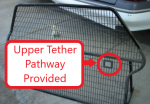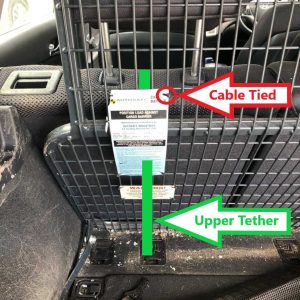How to Negotiate Cargo Barriers
 Cargo Barriers are a brilliant safety precaution that we, as child safety technicians, love to see parents and carers utilising in their vehicles – but often there can be a little something inside us that says “Ohhh what? I didn’t expect this problem!” when presented with pathway issues. This article isn’t intended to be a blanket solution, we’ve discovered that every scenario is different and sometimes fresh eyes can provide really simple solutions so if you’ve come across a scenario that has you scratching your head then please take a quick photo and email your Members Services team at info@stagingacriecho.acri.com.au.
Cargo Barriers are a brilliant safety precaution that we, as child safety technicians, love to see parents and carers utilising in their vehicles – but often there can be a little something inside us that says “Ohhh what? I didn’t expect this problem!” when presented with pathway issues. This article isn’t intended to be a blanket solution, we’ve discovered that every scenario is different and sometimes fresh eyes can provide really simple solutions so if you’ve come across a scenario that has you scratching your head then please take a quick photo and email your Members Services team at info@stagingacriecho.acri.com.au.
Common Pathway Problems
When running an upper tether to an anchor point you must always choose the most direct path possible, you will have already come across issues with head restraints in some vehicles impacting pathways and cargo barriers are no different in this respect. Your priority is to locate the most direct path.
When is it ok to run the upper tether through the cargo barrier?

If you can pass the Upper Tether Clip through the cargo barrier, even if there isn’t a provision for it, then it’s acceptable to pass through the barrier at a point where the most direct path is achieved. If you can’t get the tether clip through the barrier due to an angle or clips size issue then the trick you use for some Dual Cab Utes can be used here. Engage the upper tether clip onto the cargo barrier where you want it to pass through, then without damaging the clip, angle it through the barrier with enough force to allow it to pass through – without damaging it!
I can’t get the upper tether through the barrier – what do I do?
The path is obstructed
If the obstruction, such as a warning label, is easily removable and replaceable then the simple solution is to relocate the obstruction. In the example pictured to the left, the warning label is simply cable tied to the cargo barrier – there is nothing stopping you from removing the label and relocating it on the barrier. You must not completely remove any labelling from the barrier, it must be placed back on the barrier in another location.
The clip doesn’t fit through the barrier
This case is unfortunate but happens from time to time. If you have the tools, and ability then one option is to create provision for the upper tether by carefully removing one or two spars with an angle grinder or hacksaw, enlarging the gap between the bars in the barrier exactly where you need it to facilitate the most direct path for the upper tether. Once completed successfully you will need to;
- Smooth down all edges that could cause damage to the webbing on the upper tether with a file or other tool.
- Cover the edges surrounding the pathway, to further protect the webbing, with a rubber material. There are pre-fabricated examples available through one of our awesome Founding Members, A.R.F.A. (Automotive Restraint Fitters Australia)
- Ensure that the spar that is removed is not load supporting or part of the structural reinforcment. You must ensure you do not effect
Is there anything else I should do?
Yes – Document, including photos prior and aft of fitment, ensuring you attain the clients signature explaining the steps taken and that the client has agreed. This is integral to best practices, and good communication with your client is your best management against any future issues.
NB: This site contains information intended only for the person on the ACRI membership list and is subject to legal privilege. Any duplication or copy, even in segments, infringes on copyright

